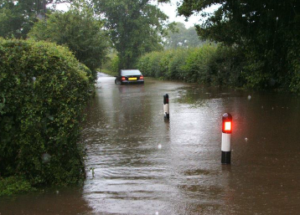130 dwellings on 4.5 hectares of largely greenfield land in Solihull. A natural watercourse crosses the site and flows into a narrow culvert under a local road, making it prone to flooding.
 Planning conditions for development included:
Planning conditions for development included:
- slowing down the flow of surface water (eg rainwater running off roofs and paved areas)
- reducing the risk of floods downstream.
The original Flood Risk Assessment and sustainable drainage system (SuDS) to tackle these challenges was impractical, and prohibitively expensive.
Time for WHS
The original response tackled the two challenges separately:
- The flow of surface water (the run-off) would be reduced to the required greenfield rate of 9.5 litres per second by building huge underground storage tanks. The ground level of the site would also be raised to allow for the tanks.
- The flood risk would be reduced by creating a pond through which the watercourse would flow.
Both planning conditions could be met with one integrated approach. The answer lay in the pond. And we could prove it.
- We used the Flood Estimation Handbook to calculate flows from the watercourse into the pond.
- We used the unique ability of ReFH 2 to model the impact of urban development in an integrated way to calculate flows of run-off into the pond.
- We ran simulations using WinDes Microdrainage software and detailed modelling of the development’s proposed drainage network.
A storage pond will hold water from both the existing watercourse and surface run-off.
A two-staged weir will control outflow for the pond. It will be able to handle the floods that typically happen once every two years, as well as exceptional floods that might occur once in a 1,000 years.
Combining the outputs from ReFH 2 and Microdrainage, we updated the ISIS hydraulic model of the area and proved our plan would work. We also gained approval from the Lead Local Flood Authority, not a straightforward task when planning conditions have already been set.
Solid science in safe hands
Our skills and our software enabled us to innovate with an integrated approach, where the traditional wisdom was to assess the two challenges independently.
Result: Regulatory approval gained, capital and maintenance costs reduced.
“Spot on. On the back of your work we will come to WHS for flood analysis work as we were very impressed with how you progressed the study. You were the only consultant that provided a clear way forward for the scheme”
Julian Lee, Engineering Manager, Bellway Homes